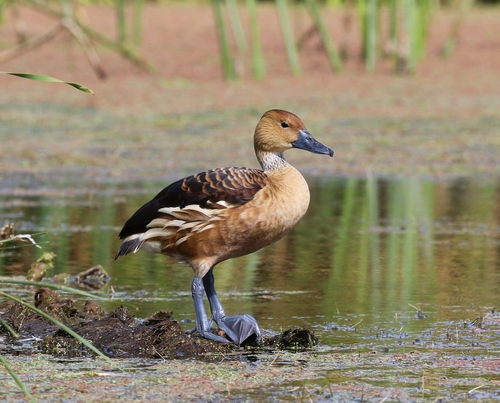
Fulvous Whistling-duck
The Fulvous Whistling-Duck (Dendrocygna bicolor) is a unique and widely distributed waterfowl species known for its distinctive, high-pitched whistling call and rich, fulvous (tawny-orange) coloration. Unlike many other ducks, it exhibits a cosmopolitan distribution, found across tropical and subtropical regions of the Americas, Africa, and Asia. Ecologically, it plays a role in seed dispersal and nutrient cycling in wetland ecosystems. It holds a relatively secure conservation status, although localized threats exist. Culturally, it is sometimes hunted for food, but it is not as heavily targeted as some other waterfowl.
45-53 cm
Length
85-93 cm
Wingspan
Least Concern
Conservation Status
Distribution
Found across discontinuous regions in North, Central, and South America, sub-Saharan Africa, the Indian subcontinent, and parts of Southeast Asia. It does not undertake long-distance migrations in the classic sense but may move regionally in response to water availability and breeding opportunities.
Lifespan
Up to 9 years in the wild, potentially longer in captivity (though specific data is limited).
Fulvous Whistling-duck's Habitat
Habitat Types
Freshwater marshes, Rice paddies, Shallow lakes, Flooded grasslands, Estuaries
Climate Zones
Tropical, Subtropical, Warm Temperate
Adaptations
Their long legs and necks are well-suited for wading in shallow water and foraging among emergent vegetation. They are also capable divers, though they primarily feed by dabbling and upending.
Variations
No widely recognized subspecies exist, although slight variations in size and plumage intensity may occur across its vast range.
Appearance
Breeding Plumage
Plumage is largely consistent year-round.
Seasonal Feather Changes
Minimal seasonal variation.
Sex Based Plumage Differences
Males and females exhibit very similar plumage.
Notable Features
Rich, fulvous (tawny-orange) body plumage., Long, dark gray legs and bill., Black-and-white striped flanks., Distinctive white stripe on the back, visible in flight.
Diet and Feeding
Primary Foods
Seeds (especially rice and other grasses), Aquatic plants, Aquatic invertebrates (in smaller quantities)
Foraging Behavior
Feeds primarily by dabbling at the water's surface, upending, and occasionally diving. Often forages in flocks, especially at night or in the early morning and late evening.
Specializations
No highly specialized feeding adaptations, but its long neck allows it to reach submerged vegetation.
Seasonal Diet Variations
Diet may shift slightly depending on the availability of seeds and other food resources in different seasons or locations.
Behavior
Social Structure
Highly gregarious, often found in flocks of varying sizes, sometimes numbering in the hundreds or even thousands, especially outside the breeding season.
Communication
Distinctive, high-pitched, three-note whistle (often described as "kee-wee-ooo")., Soft calls and quacks during close interactions.
Migration
Not a long-distance migrant, but may undertake regional movements in response to water availability and food resources. These movements are often nomadic rather than following fixed routes.
Territorial or Group Behaviors
During the breeding season, pairs may defend a small territory around the nest site. Outside the breeding season, they are highly social and non-territorial.
Conservation
Threats
Habitat loss and degradation (due to wetland drainage, agricultural expansion, and pollution), Hunting (in some regions), Pesticide poisoning (especially in rice-growing areas), Lead poisoning (from ingestion of spent lead shot)
Protection Programs
Wetland conservation and restoration efforts (beneficial but not specifically targeted at this species), Some international agreements on migratory bird protection (though this species is not a primary focus)
Local National Laws
Protected under various national wildlife laws in many countries within its range.
Population Trend
Stable
Population Estimates
The global population is estimated to be between 1,300,000 and 3,200,000 individuals.
Interesting Facts
They are one of the most widespread duck species in the world.
Their presence on multiple continents is unusual for a waterfowl species.
They are sometimes called "tree ducks".
This refers to their occasional habit of perching in trees, though they primarily nest on the ground.
They are known for their strong pair bonds.
Pairs often stay together for multiple breeding seasons.
Their chicks are able to swim and dive soon after hatching.
This gives an advantage for survival.
Faqs about Fulvous Whistling-duck
Are Fulvous Whistling-Ducks endangered?
No, they are currently classified as Least Concern by the IUCN, meaning they have a relatively stable and widespread population.
What do Fulvous Whistling-Ducks eat?
They primarily eat seeds, especially from grasses and rice, as well as other aquatic plants and some invertebrates.
Where can I see Fulvous Whistling-Ducks?
They can be found in wetlands, marshes, rice paddies, and shallow lakes across tropical and subtropical regions of the Americas, Africa, and Asia.
Do Fulvous Whistling-Ducks migrate?
They don't undertake long-distance migrations like some other ducks, but they may move regionally in response to changing water levels and food availability.
Copyright @ Nature Style Limited. All Rights Reserved.
 English
English